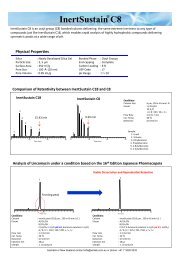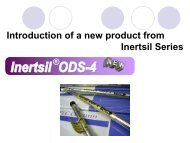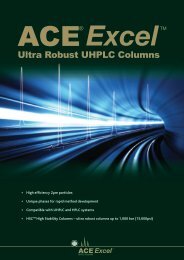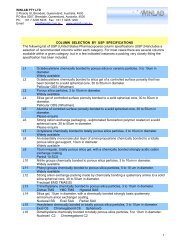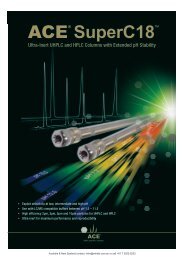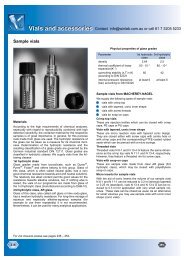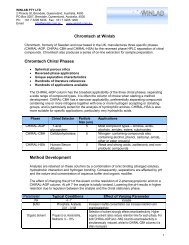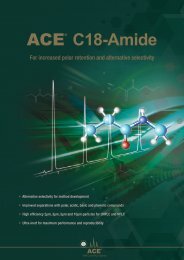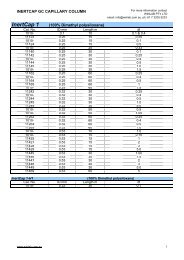Sepax Proteomix Brochure - Winlab.com.au
Sepax Proteomix Brochure - Winlab.com.au
Sepax Proteomix Brochure - Winlab.com.au
- No tags were found...
You also want an ePaper? Increase the reach of your titles
YUMPU automatically turns print PDFs into web optimized ePapers that Google loves.
Separation and Analysis of Cell LysatesThe key issue for proteome studies is to separate andidentify a large number of biological species in a cell, suchas proteins, nucleotides, peptides and others. The demandfor separation is unprecedented. With the uniqueness ofhigh resolution and high capacity, the non-porous <strong>Proteomix</strong>ion-exchange resins are very much suitable for separatingcell lysates. Figure 19(a) showed the separation profiles ofE. coli lysate with 3, 5, and 10 µm non-porous <strong>Proteomix</strong>SAX particles. The minimum number of resolved peaksincreased from 40 to 60 to 75 when the particle sizedecreased from 10 to 5 to 3 µm. To better view theseparation performance, the elution profiles in the range of10-22 minutes were shown in Figure 19(b). At least 45, 38,27 peaks were resolved at the retention time of 10-22minutes for 3, 5, and 10 µm SAX columns, respectively.Figure 20 showed various sample loading for a 3 µm,4.6x50 mm non-porous SAX column. When the amount ofE. coli lysate increased from 25 µg to 50 µg to 125 µg, theseparation efficiency and resolution remained consistent.Fig. 19(a) (Top). Separation of E. coli lysate by 3, 5 and 10 µm<strong>Proteomix</strong> SAX particles. (b) (Bottom). Expanded region ofretention time from 10 to 22 min.<strong>Proteomix</strong> SAX-NP10(10 µm, 4.6x50 mm)Peak Capacity > 40<strong>Proteomix</strong> SAX-NP5(5 µm, 4.6x50 mm)Peak Capacity > 60Column: <strong>Proteomix</strong> SAX-NP (4.6x50 mm)Mobile phase: A, 20 mM Tris, pH 9.0; B, A + 0.5 M NaClGradient: 0-100%B in 30 minFlow rate: 0.5 mL/minSample: E. coli lysate (2.5 mg/mL)Injection: 10 µLTemperature: 25 o CDetection: UV 280 nmFig. 20. Elution profile of E. coli Lysate by non-porous <strong>Proteomix</strong>SAX column with various loadings. The separation conditions arethe same as those in Fig. 19.<strong>Proteomix</strong> TM SAX-NP3 (3µm, 4.6x50mm)E. coli Lysate(2.5 mg/mL)Injection50 µL20 µL10 µL18 19 20 21Min0 2 4 6 8 10 12 14 16 18 20 22 24 26 28 30 32 34MinFig. 21. High peak capacity separation of yeast lysate by nonporous<strong>Proteomix</strong> SAX column. (Courtesy of Prof. Fred Regnier,Purdue University)1.2Peak capacity is at least 50<strong>Proteomix</strong> SAX-NP3(3 µm, 4.6x50 mm)Peak Capacity > 700 2 4 6 8 10 12 14 16 18 20 22 24 26 28 30 32 34Min1.00.8AU0.60.4-1 min-<strong>Proteomix</strong> SAX-NP10 (10 µm)0.2<strong>Proteomix</strong> SAX-NP5 (5 µm)0.00.0 2.5 5.0 7.5 10.0 12.5 15.0 17.5 20.0 22.5 25.0 27.5 30.0 32.5 35.0 37.5 40.0 42.5 45.0Min<strong>Proteomix</strong> SAX-NP3 (3 µm)10 11 12 13 14 15 16 17 18 19 20 21 22MinColumn: <strong>Proteomix</strong> SAX-NP3 (3 µm, 4.6x50 mm)Mobile phase: A, 20 mM Tris, pH 9.0; B, A + 0.5 M NaClGradient: 0-100%B in 30 minFlow rate: 0.5 mL/minSample: Yeast lysate (2.5 mg/mL)Injection: 40 µLTemperature: 25 o CDetection: UV 280 nmwww.sepax-tech.<strong>com</strong> 10 1-877-SEPAX-US



